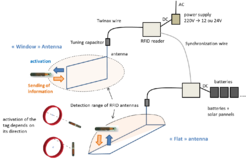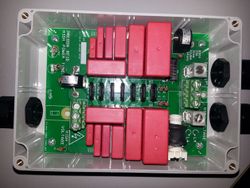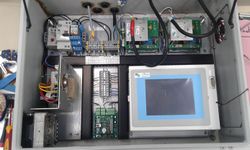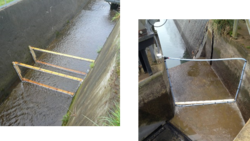Radio frequency identification with passive integrated transponder (PIT tagging)
Quick summary
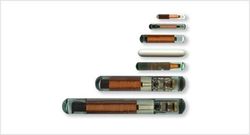
Date: 1973
Type: Tool
Suitable for the following [[::Category:Measures|measures]]:
Introduction
RFID (Radio Frequency Identification) system uses PIT (Passive Integrated Transponder) tags to detect and follow individuals. The PIT tags (Figure 1), each with a unique alphanumeric code, are of small size and benefit of indefinite operational life (no battery is required). When entering in the detection area of a RFID antenna (Figure 2), the reader is responsible of powering and communicating with the tag. The tag antenna captures energy from a tag and transfers the tag’s ID.
Low Frequency RFID uses magnetic fields that can go through water in contrast to high frequency RFID. Owing to the shorter detection range (less than 2 m perpendicular to the antenna plane) RFID technology is mainly suitable for smaller systems. Two different technologies can be used (source: https://www.oregonrfid.com/resources/hdx-fdx/):
- Half duplex RFID (HDX): A half duplex RFID reader generates short magnetic pulses that wirelessly charge a capacitor (Figure 3) inside an HDX tag. When the charge field turns off, the tag uses the stored power to send the tag number back to the reader (Figure 4) without interference from the reader.
- Full duplex RFID (FDX): Full duplex RFID generates a continuous magnetic field which powers the tag to respond immediately. Tags repeat their message, while powered by the field, up to 30 times per second.
The whole system has to be supplied by DC power, powered by different ways:
- Battery
- Solar
- Thermoelectric generator
- Micro hydro (to charge the batteries)
- A power supply can transform the AC power to DC power
Application
The RFID technique is used in FIThydro Test Cases in order to follow fishes to study their migration paths, their behaviour and to assess the efficiency of upstream and downstream migration devices and other mitigation measures on habitat.
The PIT tag has to be inserted in the fish by surgical act. For this, the fishes are anaesthetized. The tag is inserted either using a syringe or through a small incision in the abdominal cavity or muscle. Most researchers (Jepsen et al., 2005) adhere to the principle that the weight of the tag should not exceed 2 % of the total weight of the fish.
As for all experiments with living beings, the regulatory obligation must be respected: the personnel must be qualified, the company/organism must be certified and obtain the agreement of an ethics committee. The 3R rule (replace, reduce, refine) must be applied.
This technology allows tagging of very small fishes due to the small size of the tag. It allows following fishes over several years since the tag has no battery and a quasi-endless lifetime. The drawbacks are the size of the antennas and the detection range. Due to the large number of code existing, a large number of fishes can be tagged. It is not sensible to turbidity, or thermal stratification.
One threshold is the effect of metal on the detection ranges of the antennas. Indeed metal is disrupting the signal. For example, it will not be possible to install an antenna in a metal baffle fish pass.
In FIThydro this technology has been used to assess the efficiency of downstream migration devices (Figure 5), fish passes and fish behaviour systems.
Other information
The costs of the technology are acceptable: around 2 € per tag. A reader costs from 2000 to 5000 €.
Relevant literature
- Tomanova, S.; Guillemin, A.; Destouches J.P.; Allou, A., 2017, Journée d’échange technique AFB – Utilisation de la RFID, 13-15 novembre 2017.
- European committee for standardization, 2018, Water quality – Guidance for assessing the efficiency and related metrics of fish passage solutions using telemetry.
- Tétard, S.; Tomanova, S.; Courret, D.; Sagnes, P. ; Alric, A. ; De Oliveira, E. ; Lagarrigue, T. ; Frey, A. (2017), The efficiency of inclined and oriented racks to prevent Atlantic salmon smolts from entering the turbines, International conference on engineering and ecohydrology for fish passage.
- Jepsen N, Schreck C, Clements S, Thorstad E: A Brief Discussion on the 2% tag/Bodymass Rule of Thumb. In Aquatic Telemetry: Advances and Applications – Proceedings of the Fifth Conference on Fish Telemetry: 9–13 June 2005; Ustica, Italy. Edited by: Spedicato MT, Lembo G, Marmulla G. Rome: FAO; 2005:255–259.
